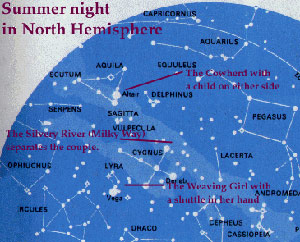Chinese Valentine's Day Comes(情系七夕)
[ 2006-07-31 09:56 ]
 The stars The stars
 Gaze up to where the Milky Way (or "Heavenly River" in Chinese)
traverses the night sky and you will see a constellation of five small stars on
the east bank. This is Vega, also called the Weaving Maid or "Zhi Nu." Opposite
to her, on the distant western bank, is Altair, also known as Cowherd or "Niu
Lang ", shining brilliantly throughout the ages -- lonely and waiting. Gaze up to where the Milky Way (or "Heavenly River" in Chinese)
traverses the night sky and you will see a constellation of five small stars on
the east bank. This is Vega, also called the Weaving Maid or "Zhi Nu." Opposite
to her, on the distant western bank, is Altair, also known as Cowherd or "Niu
Lang ", shining brilliantly throughout the ages -- lonely and waiting.
Since Vega is the fifth brightest star in the sky, it is
therefore very easy to spot on a summer night. Vega is 16 times bigger than the
sun and its surface temperature tops 10,000 degrees Celsius. Vega is also 25
times brighter than the sun and 25 light years away from Earth.
Altair, as the 11th brightest star in the sky, is also easy
to spot on a summer night. Altair is four times bigger than the sun at a surface
temperature of about 8,000 degrees Celsius. It is 11 times brighter than the sun
and 17 light years away from Earth.
Two stars Alshain and Tarazed, located on each side of
Altair, are said to be the cowherd's two children. Since the distance between
Vega and Altair is 16 light years, they cannot meet in the sky. In the story,
the magpie bridge allowed the Weaving Maid and cowherd to meet.
 The festival The festival
On Chinese
Valentine's Day, couples go to matchmaker temples to pray for everlasting love
and marriage. Even single people will frequent the temple for luck in love.
Chinese Valentine's Day is also called "The Daughter's Festival". Long ago,
Chinese girls aspired to becoming skilled craftswomen like the Weaving Maid.
This skill was considered essential to their future as wives and mothers. On
that night, unmarried girls prayed to the Weaving Maid star for the special
gift. When the star Vega was high up in the sky, girls performed a small test by
placing a needle on the water's surface: If the needle did not sink, the girl
was considered to be ready to find a husband. Once a year, on this day, girls
could wish for anything their hearts desired.
In some Chinese provinces, people believe that decorating an ox's horns with
flowers on Chinese Valentine's Day will ward off disaster. On the night of
Valentine's Day, women wash their hair to give it a fresh and shiny look;
children wash their faces the next morning using the overnight water in their
backyards for a more naturally beautiful appearance; and girls throw
five-colored ropes made during the Chinese Dragon Boat Festival on the roofs so
magpies can use them to build the bridge.
(來源:中國文化網(wǎng)
英語點(diǎn)津陳蓓編輯)
|